
VIA BICI is a community-led service to improve cycling safety and experience in Milan through bicycle-friendly navigation, user participation, and collaborative efforts with local communities.
DURATION
3 Months
09/2022-01/2023
TEAM
Alice D'Adda
Anita Colombo
Giulia Pietracaprina
Kaer Xiong
Kudrat Kurban
Shrishti Checker
CONTRIBUTION
Concept Generation
User Experience
Product Service System Research
Co-design and Prototyping
Business Design
OVERVIEW
According to the plan of the Municipality of Milan: The PGTU - General Urban Traffic Plan, we, as students of Product Service System Design at Politecnico di Milano, were called upon to implement the objectives of improving traffic and parking conditions, safety, reducing pollution and implementing active mobility solutions. Combining our professional background and early exploration of the current situation, we identified Soft and Slow Mobility as the main research direction.
We, as a research team, conducted research for a month and created a new solution that promotes biking in Milan. VIA BICI encourages cyclists to choose the best route and report any issues they face while biking, especially in areas where infrastructure is lacking. The Milan Municipal Transportation Management Department can use the platform's data to assist with policy-making. Businesses, organizations, and communities can also use VIA BICI to encourage their members to bike more and help achieve sustainability goals for the city.
Our solution was well received by the course professor and the manager of the Mobility Department at Politecnico di Milano. We were invited to present it to officials from the Mobility Planning and Programming Department of the Municipality of Milan.
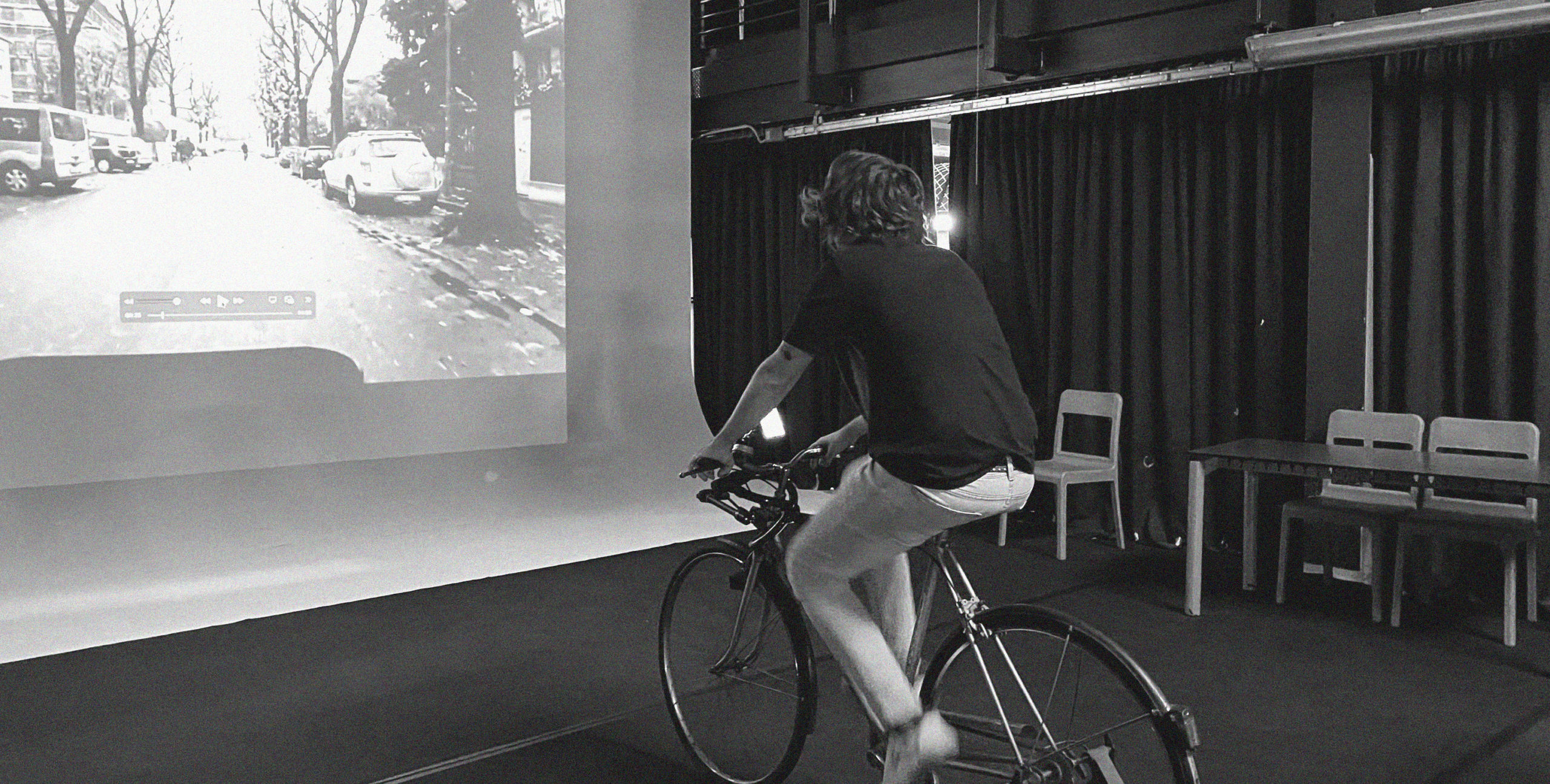
PROCESS
We developed a three-part plan: background and problem research, solution generation, and solution optimization. During this time, we organized several expert interviews and scenario-based research to confirm the authenticity and importance of the requirements in a complex system.
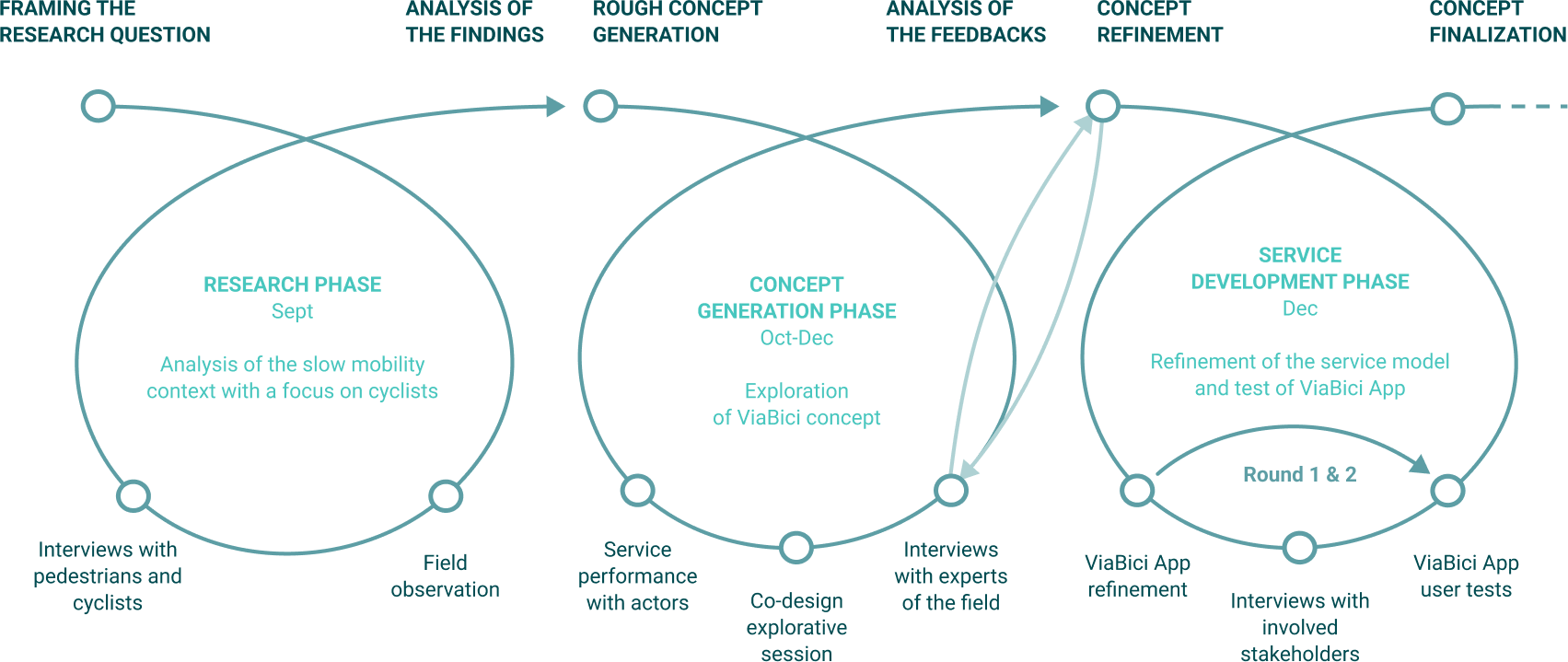
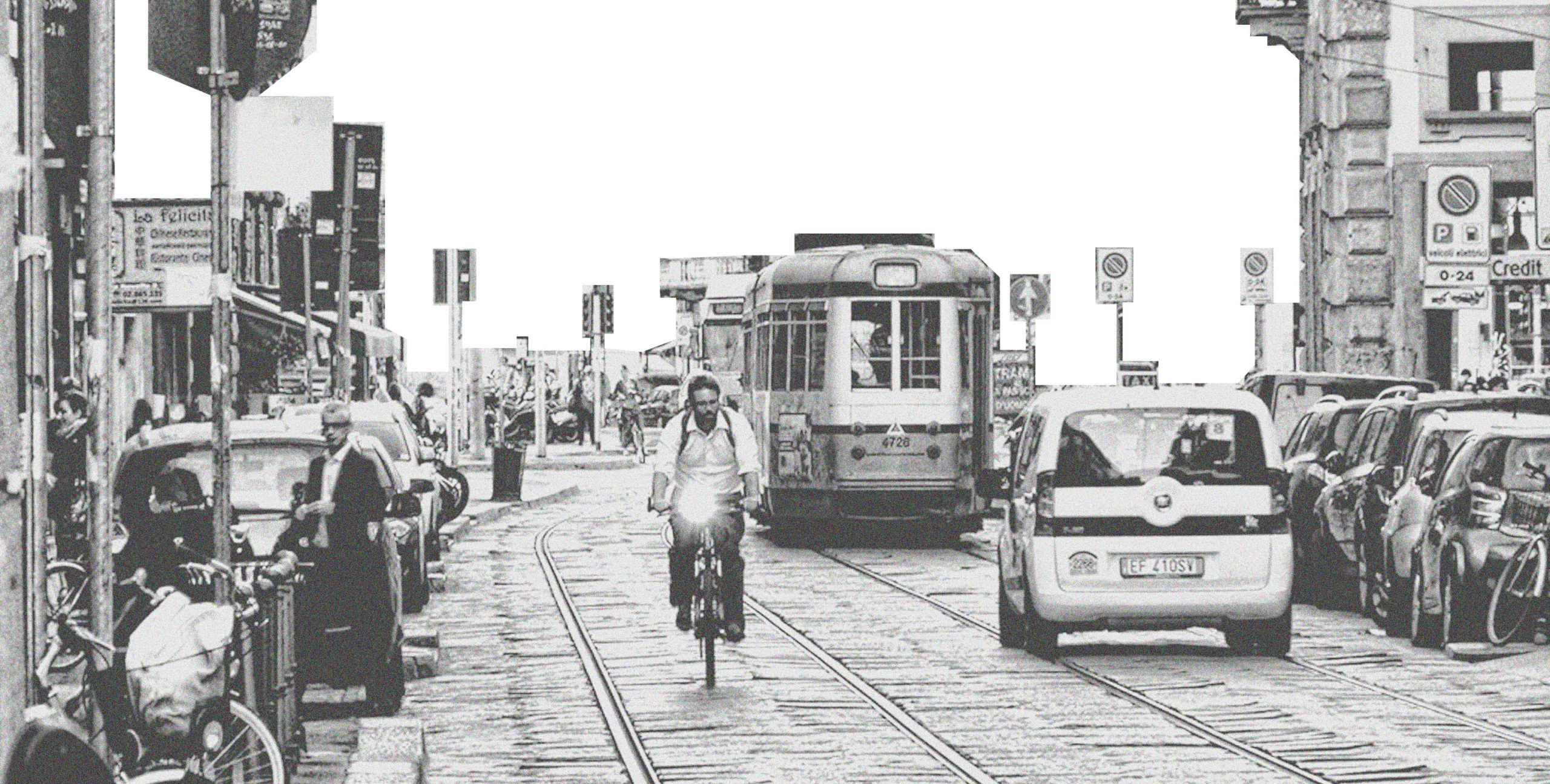
BACKGROUND
National and urban policy makers along with the citizens are facing the consequences of more than 70 years of urban development around unsustainable, private and individual mobility: urban sprawl, traffic congestion, air and noise pollution, road accidents, social segregation and much more.
Many different players are working on mobility services to promote sustainable and inclusive scenarios involving different communities. We chose to work in this direction and explore more on Slow Mobility. Slow or Soft mobility refers to pedestrian, bicycle, roller skate and skateboard transfers. It is as “zeroimpact” mobility that can optimise urban liveability.
The average travel distance covered by the citizens in Milan is less than 5kms. In today’s date, Milan has 298 kms of cycle lanes and ‘Cambio: Biciplan of the Metropolitan City of Milan’ outlines strategies to increase the use of the bicycle and reach ~370 km of cycle lanes by 2035.
However, research shows that cars are chosen by 32% citizens and this percentage ties up with the usage of other public transportation modes. Cumulatively, these fast mobility modes make up a huge majority.
The project investigates the root causes for lower percentages of cycling mobility in Milan and addresses them through the service of Via Bici.
PROBLEM STATEMENT
How can we effectively promote and increase the use of cycling as a slow mobility mode, to transform cities towards sustainable and inclusive mobility, while addressing the barriers and challenges that hinder their adoption and creating a safe and accessible urban environment for all?
RESEARCH
Ethnographic field research and expert interviews were conducted during the research phase. The expert interviews conducted were with specialists working in the cycling mobility field at a municipality level as well as in association with private and public organisations.
The research phase was pivotal in understanding the topic of slow mobility and framing the problem statement in the context of Milan.
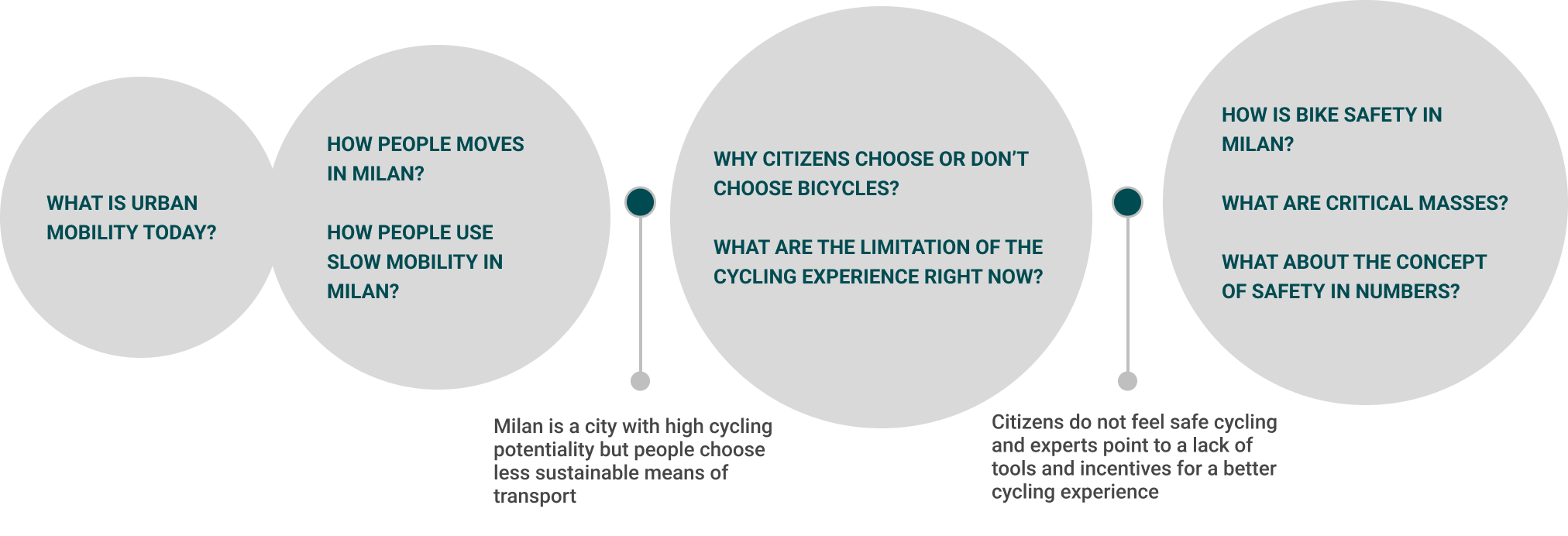
WHY PEOPLE DON'T CYCLE IN MILAN?

LACK OF INFORMATION
There is a lack of information regarding the best roads to cycle, from the point of view of comfort and safety.
DON’T FEEL SAFE
People don’t feel safe cycling in the city. Perceived safety is very low.
STRATEGY
Regarding bicycle safety, the first solutions are thought to involve urban or infrastructural changes: building cycle lanes, resurfacing roads, creating dedicated areas, etc. Our research, however, wants to focus on simpler actions that can change the type of experience a cyclist can have in the city of Milan. We came across two very interesting phenomena related to the topic: Critical Masses and the concept of 'Safety in numbers'.
Critical Masses are a gathering of bicycles that, thanks to the high number of adhesions, lock or make the circulation of motorized vehicles on city streets more difficult. This kind of initiative, which is quite subversive from a city point of view, aims to raise awareness among people but above all among the municipality on the issue of cycling in cities.
What makes Critical Masses interesting is the importance this type of event gives citizens, understood not just as a number 'to annoy' but as a number 'to change'.
From the concept of Critical Mass, it is very easy to link to the phenomenon of 'Safety in numbers', i.e. the correlation between cyclability and accident reduction, according to a very simple equation:
The more cyclists, the safer.
HOW MIGHT WE
Create a service that enables cyclists to live a safer and more enjoyable travel experience?
IDEATION
The initial concept was a cycle navigation map co-created by the users themselves to map the streets of Milan, highlighting the most dangerous, unsuitable or particularly busy streets. The aim was to create a safer cycling experience.
However, we see through the following sections, the concept was drastically evolved further through multiple co-design sessions, expert interviews and prototyping sessions.
ACTORS & POTENTIAL USERS
Through the desk research and interviews, we pinpointed 4 kinds of potential users and understood their goals and needs:
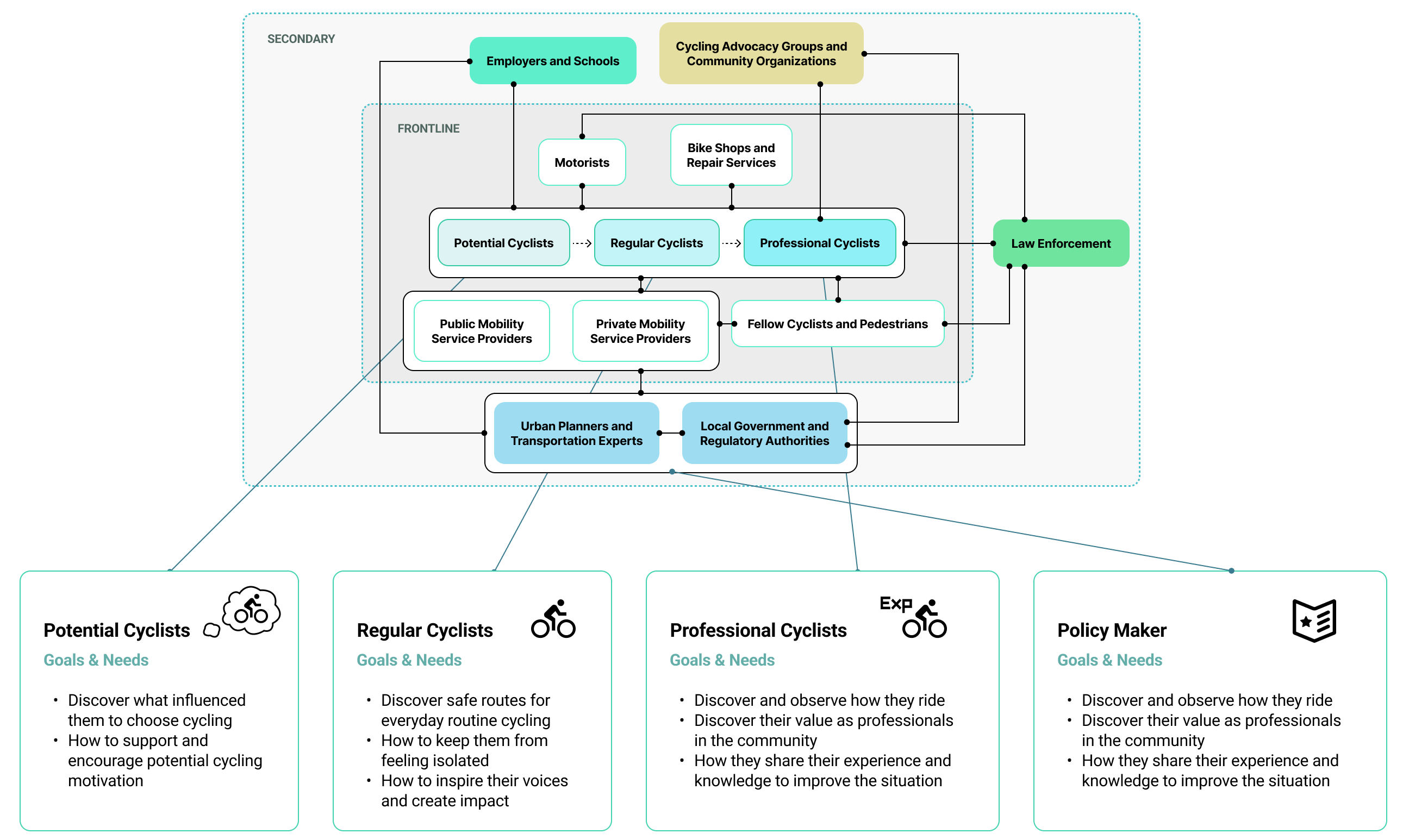
OPPORTUNITIES
We developed a three-part plan: background and problem research, solution generation, and solution optimization. During this time, we organized several expert interviews and scenario-based research to confirm the authenticity and importance of the requirements in a complex system.

FINAL SERVICE CONCEPT
Via Bici is a PoliMI community-led service that leverages the concept of safety in numbers to guide and channel cyclists on the same paths through navigation services.
Via Bici leverages the concept of safety in numbers by guiding and channeling cyclists through navigation services and encourages them to report feedback on critical points and segments.
The service incentivises feedback collection through a reward-based system and attracts expert cyclists to act as ambassadors, who can suggest safer and more enjoyable routes to the community according to their experience.
GOAL
We developed a three-part plan: background and problem research, solution generation, and solution optimization. During this time, we organized several expert interviews and scenario-based research to confirm the authenticity and importance of the requirements in a complex system.
Perception
Increase the perception of bike-friendly routes despite the infrastructure.
Community
Create an involved and empowered community that can be heard.
Encouragement
Encourage as many people as possible to choose the bike over other means of transport.
ITERATION
We developed a three-part plan: background and problem research, solution generation, and solution optimization. During this time, we organized several expert interviews and scenario-based research to confirm the authenticity and importance of the requirements in a complex system.
PROTOTYPING & MVP
We developed a three-part plan: background and problem research, solution generation, and solution optimization. During this time, we organized several expert interviews and scenario-based research to confirm the authenticity and importance of the requirements in a complex system.
FINAL DESIGN
We developed a three-part plan: background and problem research, solution generation, and solution optimization. During this time, we organized several expert interviews and scenario-based research to confirm the authenticity and importance of the requirements in a complex system.
EVALUATION
We developed a three-part plan: background and problem research, solution generation, and solution optimization. During this time, we organized several expert interviews and scenario-based research to confirm the authenticity and importance of the requirements in a complex system.
REFLECTION
We developed a three-part plan: background and problem research, solution generation, and solution optimization. During this time, we organized several expert interviews and scenario-based research to confirm the authenticity and importance of the requirements in a complex system.


